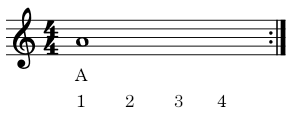Strumming and Rhythm Guitar Lesson
Part 1 : Learn some basic rhythms and a fun strum pattern!
Strumming Lesson 1
Video Time: 7:20
Part 1 of the Secrets of Strumming. Learn basic note values and how to count them and learn a couple very common strum patterns!
Having taught over 20 years, strumming and playing in time is a common problem I see. It is easy to pick up bad habits and not being able to play in time makes it difficult to play with others and for anything to sound right. The good news, you can avoid those bad habits....
Register for FREE 3 Part Series
Get the first 3 parts of The Secrets of Strumming for Free by entering your name and email. If you enjoy it and want the rest you will be given the option to get the rest of the course for a great price just for trying the first 3 for Free!
![]() We value your privacy and would never spam you
We value your privacy and would never spam you
Let's Get Started
First some basic notation
First let's start by looking at the time signature that helps us understand how to count and divide up time!
To the right we have the staff with a treble clef and time signature. In this example it is called Three Four time.

The top number is going to tell us how many beats we can have in a measure. More on this below.
The bottom note will tell us what kind of note gets the beat.
You can also think of the bottom note to represent the value of the whole note.
If we had a key signature (flats or sharps) it would go between the clef and time signature. More on this later 🙂
C represents Common time which is also known as 4/4. The measure to the right has a whole note rest in it to signify not to play anything for 4 beats (in this case 1 measure) and has a final bar line at the end to signify the end of a piece of music.

In this example we have two measures divided by a bar line with each of these measures having a whole note rest in them. So in this example you wouldn't play anything for 8 beats (in this case 2 measures).

Whole Note
Worth 4 beats in 4/4
0:18 - 0:44
The whole note is held for the value of the bottom number in the time signature. In 4/4 or Common time the bottom number is 4 and so the whole note is held for 4 beats. Because the top number is also 4 we can only have 4 beats in a measure. Since the whole note is worth 4, we can't fit anything else in this measure.
Half Note
Worth 2 beats in 4/4
Quarter Note
Worth 1 beat in 4/4
Eighth Note
Worth 1/2 a beat in 4/4
Sixteenth Note
Worth 1/4 of a beat in 4/4
Chord Graphs
2:14 - 2:22
To the right is a whole note written for a chord chart. In 4/4 time we will hold this for 4 beats. So without a chord written above we don't know what to play. Only that whatever it is will be held for 4.


2:23 - 2:28
To the right are two half notes worth two beats each in 4/4. So in this case we will hit them on beat 1 and 3.

2:29 - 2:32
Notice I have included down strokes above the chord chart.

2:33 - 2:43
We count these eighth notes like: 1 & 2 & 3 & 4 &.
In this example we will play up and down strokes. So note that when you were playing quarter notes you were playing all down but you had to come back up in between the down strokes. Now you just have to catch the strings on the way back up.

2:44 - 2:47
We will count sixteenth notes: 1 e & a

Pattern 1
Using Quarter Notes and Eighth Notes
3:54 - 4:34
Now let's take all this above info and learn a strum pattern! This is an easy one with two quarter notes on beat 1 and 2 and then four eighth notes making up beats 3 and 4.

Pattern 2
Using Quarter Notes and Eighth Notes
4:35 - to end
This pattern is similar to pattern 1 but we have now moved the four eighth notes to beats 2 and 3! We will work on speeding this pattern up.


The Secret to Strumming Series
The Ultimate Guide to Mastering Strumming
Hi my name is Teague and thank you so much for checking out my page on strumming.
From 20 plus years of teaching, one of the most problematic areas I see students struggle with is strumming. Bad habits can easily form and cause significant problems that make it difficult to play in time, play along with others or make anything sound right. Not to mention, how much harder it makes to progress as an overall player. Rhythm is everything.
The good news, it is all very easily solved. And you already started by doing the lesson above. 🙂
Click below to continue a few more parts of the series for Free!!
Register for FREE 3 Part Series
Get the first 3 parts of The Secrets of Strumming for Free by entering your name and email and hitting submit. If you enjoy it and want the rest you will be given the option to get the rest of the course for a great price just for trying the first 3 for Free!
![]() We value your privacy and would never spam you
We value your privacy and would never spam you






